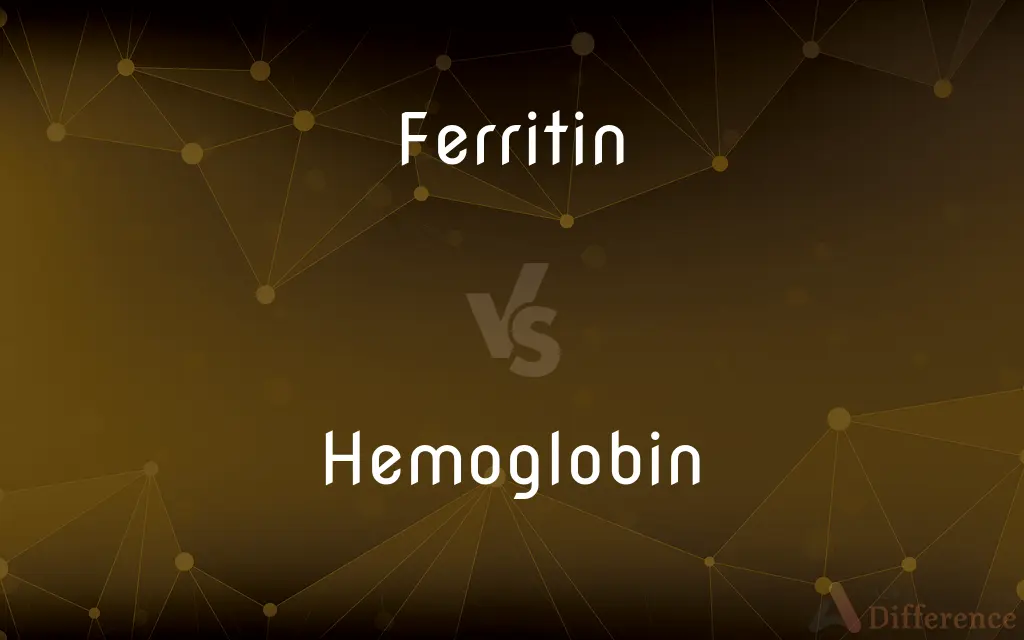Ferritin vs. Hemoglobin — What's the Difference?
Edited by Tayyaba Rehman — By Fiza Rafique — Updated on October 6, 2023
Ferritin is a protein that stores iron in cells. Hemoglobin is a protein in red blood cells that carries oxygen.

Difference Between Ferritin and Hemoglobin
Table of Contents
ADVERTISEMENT
Key Differences
Ferritin serves as the primary storage molecule for iron within cells, ensuring the vital metal is available for critical physiological processes. On the other side, hemoglobin has the primary function of transporting oxygen from the lungs to the tissues and facilitating the return journey for carbon dioxide from the tissues to the lungs.
The level of ferritin in the blood also acts as an indirect indicator of the total amount of iron stored in the body. Hemoglobin concentration, however, reflects the blood’s ability to carry oxygen and is not primarily associated with iron storage but rather its utilization in the bloodstream.
It's imperative to note that ferritin is found in the liver, spleen, skeletal muscles, and bone marrow, essentially safeguarding iron for future hemoglobin synthesis. Hemoglobin, however, is predominantly located within red blood cells, symbolizing its exclusive role in facilitating oxygen transport.
Furthermore, a deficiency in ferritin can indicate a reduced iron store, potentially leading to iron-deficiency anemia if it persists. Contrarily, low levels of hemoglobin, irrespective of ferritin status, are diagnostic of anemia, reflecting an impaired oxygen-transporting capacity of the blood.
Lastly, elevated ferritin can signify a condition of iron overload, which can be detrimental to vital organs if left unchecked. In contrast, high hemoglobin levels might point towards conditions like polycythemia, indicating an excessive production of red blood cells, which could elevate the risk for thrombosis.
ADVERTISEMENT
Comparison Chart
Primary Function
Stores iron in cells.
Carries oxygen in blood.
Indicator of
Total iron stores in the body.
Blood’s oxygen-carrying capacity.
Location
Found in liver, spleen, muscles, and bone marrow.
Predominantly found in red blood cells.
Deficiency Implications
May lead to iron-deficiency anemia.
Diagnostic of anemia.
Overabundance Implications
Suggests iron overload.
Indicates conditions like polycythemia.
Compare with Definitions
Ferritin
A molecule found in various body tissues including the liver and spleen.
Ferritin safely stores iron, preventing toxicity.
Hemoglobin
A vital component in diagnosing anemia through blood tests.
Physicians assess hemoglobin to gauge blood’s oxygen-carrying capacity.
Ferritin
A factor in preventing iron-deficiency anemia by storing iron.
Sufficient ferritin levels are crucial for overall health.
Hemoglobin
Present in red blood cells, facilitating oxygen transport.
Healthy hemoglobin levels are essential for oxygen delivery.
Ferritin
An indicator of the total iron reserves in the body.
Doctors often test ferritin to diagnose iron-related disorders.
Hemoglobin
Essential for removing carbon dioxide from tissues.
Hemoglobin aids in maintaining the body’s pH balance.
Ferritin
A protein responsible for iron storage in cells.
Elevated ferritin levels can indicate iron overload.
Hemoglobin
A protein that transports oxygen throughout the body.
Hemoglobin binds to oxygen molecules in the lungs.
Ferritin
Can reflect iron status when measured in blood tests.
Ferritin tests are a common component of health check-ups.
Hemoglobin
Composed of iron, it gives red blood cells their color.
The iron in hemoglobin binds to oxygen, aiding its transport.
Ferritin
Ferritin is a universal intracellular protein that stores iron and releases it in a controlled fashion. The protein is produced by almost all living organisms, including archaea, bacteria, algae, higher plants, and animals.
Hemoglobin
Hemoglobin, or haemoglobin (spelling differences) (from Greek αἷμα, haîma 'blood' + Latin globus 'ball, sphere' + -in) (), abbreviated Hb or Hgb, is the iron-containing oxygen-transport metalloprotein in the red blood cells (erythrocytes) of almost all vertebrates (the exception being the fish family Channichthyidae) as well as the tissues of some invertebrates. Hemoglobin in blood carries oxygen from the lungs or gills to the rest of the body (i.e.
Ferritin
An iron-containing protein complex, found principally in the intestinal mucosa, spleen, and liver, that functions as the primary form of iron storage in the body.
Hemoglobin
The protein in the red blood cells of vertebrates that carries oxygen from the lungs to tissues and that consists of four polypeptide subunits, each of which is bound to an iron-containing heme molecule.
Ferritin
(protein) Any of a family of iron-carrying globular protein complexes consisting of 24 protein subunits.
Hemoglobin
(American spelling) The iron-containing substance in red blood cells that transports oxygen from the lungs to the rest of the body; it consists of a protein (globulin), and haem (a porphyrin ring with an atom of iron at its centre).
Ferritin
A protein containing 20% iron that is found in the intestines and liver and spleen; it is one of the chief forms in which iron is stored in the body
Hemoglobin
The normal coloring matter of the red blood corpuscles of vertebrate animals. It is composed of hematin and globulin, and is also called hæmatoglobulin. In arterial blood, it is always combined with oxygen, and is then called oxyhemoglobin. It crystallizes under different forms from different animals, and when crystallized, is called hæmatocrystallin. See Blood crystal, under Blood.
Hemoglobin
A hemoprotein composed of globin and heme that gives red blood cells their characteristic color; function primarily to transport oxygen from the lungs to the body tissues;
Fish have simpler hemoglobin than mammals
Common Curiosities
Is hemoglobin only found in the blood?
Predominantly, yes. Hemoglobin is primarily found in red blood cells.
What is the fundamental role of hemoglobin?
Hemoglobin transports oxygen in the blood and aids in removing carbon dioxide.
Can one live with low levels of hemoglobin?
Persistently low hemoglobin, or anemia, requires medical attention.
Can high ferritin levels be harmful?
Yes, elevated ferritin may suggest harmful iron overload.
Does ferritin carry oxygen like hemoglobin?
No, ferritin primarily stores iron and does not transport oxygen.
Does hemoglobin store iron like ferritin?
No, hemoglobin uses iron to bind oxygen but doesn’t store it.
Where is ferritin found in the body?
Ferritin is in the liver, spleen, skeletal muscles, and bone marrow.
What is the primary function of ferritin?
Ferritin stores iron in cells and indicates body iron reserves.
Can ferritin levels diagnose anemia?
Yes, low ferritin levels can indicate iron-deficiency anemia.
How does hemoglobin transport oxygen?
Hemoglobin binds oxygen in the lungs and releases it in tissues.
Can ferritin levels indicate other health conditions?
Yes, ferritin levels can also reflect inflammation or liver disease.
Why is hemoglobin crucial for bodily functions?
Hemoglobin is vital for transporting oxygen and maintaining pH balance.
Can ferritin and hemoglobin levels be checked simultaneously?
Yes, both can be assessed in a comprehensive blood test.
What indicates higher hemoglobin levels?
High hemoglobin may suggest conditions like polycythemia.
How are ferritin levels checked?
Ferritin is typically checked through a blood test.
Share Your Discovery

Previous Comparison
Restaurant vs. Cafeteria
Next Comparison
Idealism vs. RealismAuthor Spotlight
Written by
Fiza RafiqueFiza Rafique is a skilled content writer at AskDifference.com, where she meticulously refines and enhances written pieces. Drawing from her vast editorial expertise, Fiza ensures clarity, accuracy, and precision in every article. Passionate about language, she continually seeks to elevate the quality of content for readers worldwide.
Edited by
Tayyaba RehmanTayyaba Rehman is a distinguished writer, currently serving as a primary contributor to askdifference.com. As a researcher in semantics and etymology, Tayyaba's passion for the complexity of languages and their distinctions has found a perfect home on the platform. Tayyaba delves into the intricacies of language, distinguishing between commonly confused words and phrases, thereby providing clarity for readers worldwide.
















































